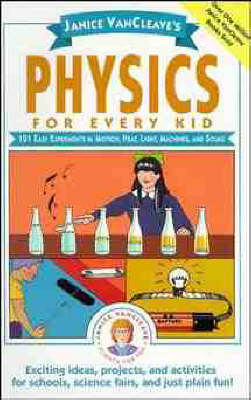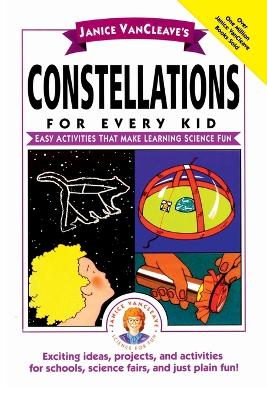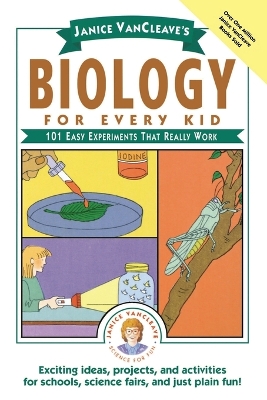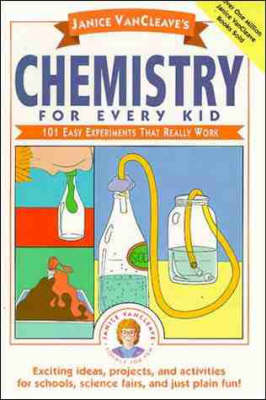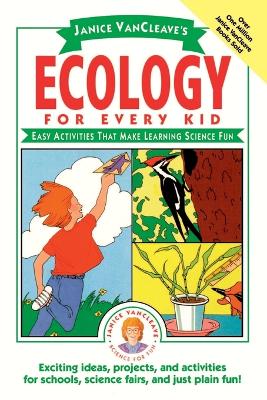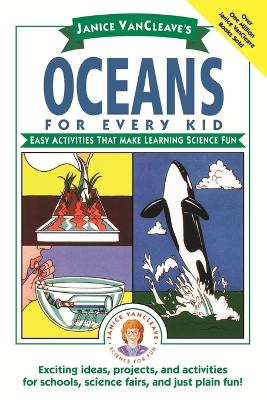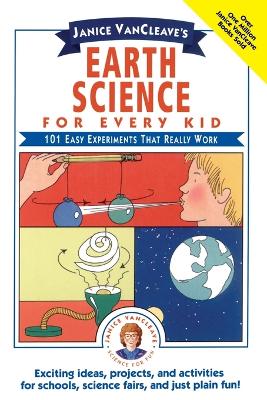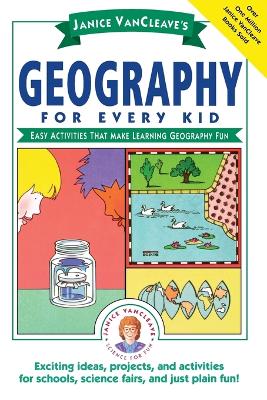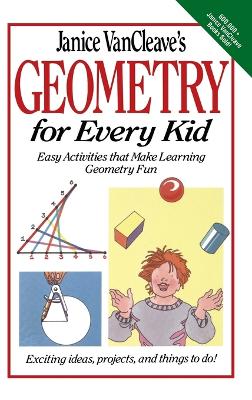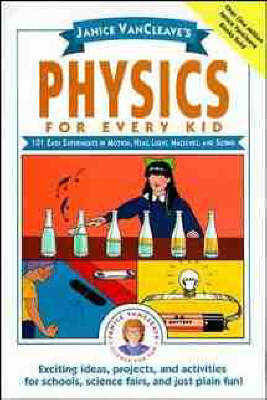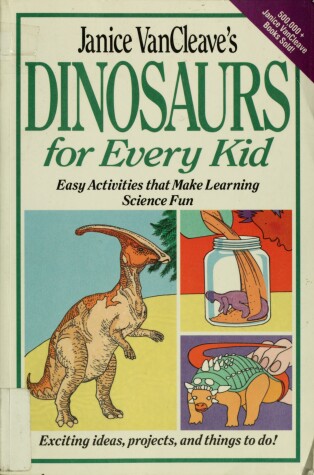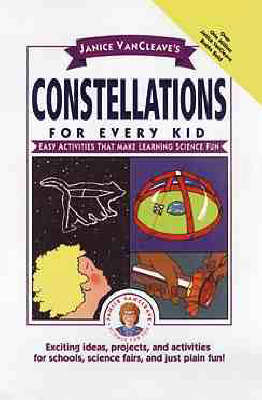Science for Every Kid
8 primary works • 18 total works
Book 69
Book 90
Book 115
How can you bring a constellation into your room?
What are the oldest stars?
How did the Milky Way Galaxy get its name?
Now you can explore the answers to these and other questions inJanice VanCleave's Constellations for Every Kid. Find theconstellations Draco, Libra, Hydra, Hercules, and many more fromyour own backyard. Make a star disk that can track star movements.Find out what a balloon can tell us about stars. With activitieslike making an astronomer's flashlight and a shoebox planetarium,Janice VanCleave's Constellations for Every Kid will have youreaching for the stars.
Each of the activities begins with a statement of purpose, followedby a list of materials, step-by-step instructions, expectedresults, and an easy-to-understand explanation. Every activity hasbeen pretested and can be performed safely and inexpensively athome or in the classroom.
Also available in this series from Janice VanCleave:
* ASTRONOMY FOR EVERY KID
* BIOLOGY FOR EVERY KID
* CHEMISTRY FOR EVERY KID
* DINOSAURS FOR EVERY KID
* EARTH SCIENCE FOR EVERY KID
* ECOLOGY FOR EVERY KID
* GEOGRAPHY FOR EVERY KID
* GEOMETRY FOR EVERY KID
* THE HUMAN BODY FOR EVERY KID
* MATH FOR EVERY KID
* OCEANS FOR EVERY KID
* PHYSICS FOR EVERY KID
Book 119
Book 130
Plus, all projects have been pretested so you can perform them safely and inexpensively in the classroom, at a science fair, or at home! Also available in the "Science for Every Kid" series: "Astronomy"; "Biology"; "Chemistry"; "Constellations"; "Dinosaurs"; "Earth Science"; "Ecology"; "Geography"; "Geometry"; "The Human Body"; "Math"; "Oceans"; and, "Physics".
Book 131
Book 132
Book 133
How does bleach make colors disappear?
Why can't you mix oil and water?
Find out the answers to these and other mysteries of chemistry inthis fascinating collection of ideas, projects, and activities thatteach the basics of chemistry theory and practice.
Turn steel wool into a glutinous green blob. Separate an egg fromits shell without breaking the shell. Make copper pennies turngreen. Have fun while you learn simple chemistry from a solution ofcolored water, and the behavior of gases with the help of a sodabottle. Through these and other activities, you'll explore thestructure of matter, the workings of acids, gases, and solutions .. . and much more.
You'll find most of the materials you need around the house orclassroom. Every activity has been pretested and can be performedsafely and cheaply in the classroom, at a science fair, or athome.
Also available in this series from Janice VanCleave:
* ASTRONOMY FOR EVERY KID
* BIOLOGY FOR EVERY KID
* DINOSAURS FOR EVERY KID
* EARTH SCIENCE FOR EVERY KID
* GEOGRAPHY FOR EVERY KID
* GEOMETRY FOR EVERY KID
* THE HUMAN BODY FOR EVERY KID
* MATH FOR EVERY KID
* PHYSICS FOR EVERY KID.
How can a jackrabbit survive in the desert?
Why is the climate cooler higher in the mountains?
Now you can learn the answers to these and other questions aboutecology. With the ideas and activities in Ecology for Every Kid,you'll have fun exploring everything from your role in spreadingplant seeds, to greenhouse gases' effect on the earth'stemperature.
Use a raisin cookie, a pencil, and a toothpick to learn how awoodpecker gets its food. With uncooked rice and a sock, see how amountain goat maintains its footing on rocky slopes. In otherfascinating projects, you'll find out how a cactus stores water,how fox-hunting affects tree growth, and much more.
You'll find most of the materials you need around the house orclassroom. The book also contains many helpful diagrams andillustrations plus a glossary of bold-faced terms for you to referto whenever necessary. Every activity has been pretested and can beperformed safely and inexpensively in the classroom or athome.
Also available in this series from Janice VanCleave:
ASTRONOMY FOR EVERY KID
BIOLOGY FOR EVERY KID
CHEMISTRY FOR EVERY KID
DINOSAURS FOR EVERY KID
EARTH SCIENCE FOR EVERY KID
GEOGRAPHY FOR EVERY KID
GEOMETRY FOR EVERY KID
THE HUMAN BODY FOR EVERY KID
MATH FOR EVERY KID
PHYSICS FOR EVERY KID
How do whales stay warm?
What causes tides to rise and fall?
How do oil spills affect ocean animals?
Now you can discover the answers to these and many otherfascinating questions about the ocean--the earth's last frontier.Janice VanCleave's Oceans for Every Kid makes learning about theocean and its inhabitants an intriguing adventure. Use a bottle,pennies, a straw, and clay to demonstrate how submarines rise. Makeyour own wave holder with index cards and a plastic folder. Throughthese and other activities you'll find out how fish move up anddown in water, how pollutants move into the ocean, how to navigatewithout a compass, how to map the surface of the ocean floor, andmuch more.
Each of the activities begins with a statement of purpose followedby a list of materials, step-by-step instructions, expectedresults, and an easy- to-understand explanation. Every activity hasbeen pretested and can be performed safely and inexpensively athome or in the classroom.
Also available in the series from Janice VanCleave:
* ASTRONOMY FOR EVERY KID
* BIOLOGY FOR EVERY KID
* CHEMISTRY FOR EVERY KID
* DINOSAURS FOR EVERY KID
* EARTH SCIENCE FOR EVERY KID
* ECOLOGY FOR EVERY KID
* GEOGRAPHY FOR EVERY KID
* GEOMETRY FOR EVERY KID
* THE HUMAN BODY FOR EVERY KID
* MATH FOR EVERY KID
* PHYSICS FOR EVERY KID
What makes the air we breathe?
What causes the ocean waves?
Now you can learn the answers to these and other questions aboutthe earth, sea, and air through 101 fun, safe, low-cost experimentsand activities that can be performed at home or in the classroom.In Earth Science for Every Kid, you'll use a tennis ball and amarble to demonstrate a solar eclipse. You'll make a peanut butterand jelly sandwich to understand sedimentary rock formation. And,with the assistance of a Slinky(r) and a helper, you'll learn aboutthe motion of water waves.
Each of the 101 experiments is broken down into its purpose, a listof materials, step-by-step instructions, expected results, and aneasy to understand explanation. Every activity has been pretestedand can be performed safely and inexpensively in the classroom orat home.
Also available in this series from Janice VanCleave:
* ASTRONOMY FOR EVERY KID
* BIOLOGY FOR EVERY KID
* CHEMISTRY FOR EVERY KID
* DINOSAURS FOR EVERY KID
* GEOGRAPHY FOR EVERY KID
* GEOMETRY FOR EVERY KID
* THE HUMAN BODY FOR EVERY KID
* MATH FOR EVERY KID
* PHYSICS FOR EVERY KID
Astronomy for Every Kid
Biology for Every Kid
Chemistry for Every Kid
Dinosaurs for Every Kid
Earth Science for Every Kid
Geometry for Every Kid
The Human Body for Every Kid
Math for Every Kid
Physics for Every Kid
Biology for Every Kid
Chemistry for Every Kid
Dinosaurs for Every Kid
Earth Science for Every Kid
Geography for Every Kid
Geometry for Every Kid
The Human Body for Every Kid
Math for Every Kid
Physics for Every Kid
Now you can discover the answers to these and other fascinatingquestions about elementary geometry--the study of shapes. Packedwith illustrations, Geometry for Every Kid uses simple problems andactivities to teach about acute and obtuse angles, parallel andperpendicular lines, plane and space figures, and much more! Byarranging the pieces of an intriguing Chinese puzzle called atangram, you'll explore all the different shapes you can form.You'll also learn how to create a colorful 3-D drawing that seemsto rise right off the page! And, by building a geoboard, you'lldiscover a quick, fun way to compare the area of differentgeometric figures.
Each of the activities is broken down into its purpose, a list ofmaterials, step-by-step instructions, expected results, and an easyto understand explanation. Every project has been pretested and canbe performed safely and inexpensively in the classroom or athome.
Also available in this series from Janice VanCleave:
* ASTRONOMY FOR EVERY KID
* BIOLOGY FOR EVERY KID
* CHEMISTRY FOR EVERY KID
* DINOSAURS FOR EVERY KID
* EARTH SCIENCE FOR EVERY KID
* GEOGRAPHY FOR EVERY KID
* THE HUMAN BODY FOR EVERY KID
* MATH FOR EVERY KID
* PHYSICS FOR EVERY KID
